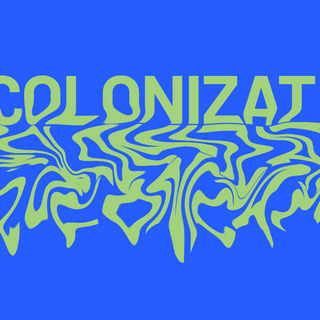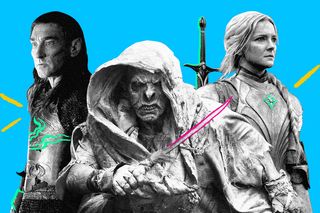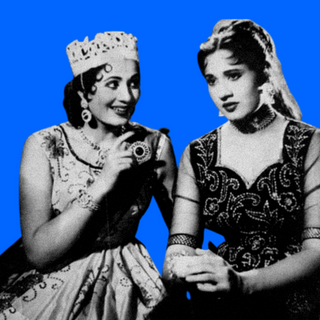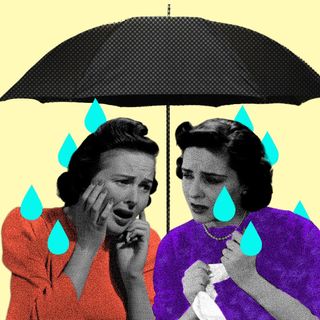
‘Rings of Power’ Complicates Orcs — And That’s a Good Thing
Orcs were canonically an irredeemably evil race. In Rings of Power, they’re a vilified race socially constructed as evil.

Amazon’s behemoth prequel series to The Lord of the Rings concluded last Friday with some big reveals. We finally know who Sauron was and we also know that The Stranger is irrevocably good — even if it takes him a minute to get there. But the series’ most interesting arc isn’t that of secret identities or grim prophetic tidings. It’s to do with orcs — a race of creatures so irredeemably evil that heroes have a greater claim to virtue for having slain as many of them as possible. But it’s not so simple.
Do orcs have souls? Are they merely enslaved, but otherwise capable of agency? What makes them different from dwarves, who were also said to be originated from stone, as per The Silmarillion? These are questions that Tolkien himself grappled with. And Rings of Power may have added more nuance to the conversation — which is all the more resonant against the racist backlash against the show for its actors of color portraying the “good” guys.
One of the theses in Jeffrey Jerome Cohen’s Monster Theory is this: “The monster dwells at the gates of difference.” In Middle Earth, orcs are terrible creatures born out of the darkness, with corruption running through their blood. Their physical descriptions are meant to evoke repulsion and disgust, with their speech — Sauron’s Black Speech — meant to be indiscernible to the ear that resides in the light.
What all these have in common is the emphasis on darkness as other, and evil. It’s an emphasis on difference insofar as it assumes that the readers — those who are meant to identify with the protagonists — are white. In her book The Dark Fantastic, scholar Ebony Elizabeth Thomas notes: “The traditional purpose of darkness in the fantastic is to disturb, to unsettle, to cause unrest. This primal fear of darkness and Dark Others is so deeply rooted in Western myth that it is nearly impossible to find its origin.”
Many have argued that such fantasy tropes are derived from how whiteness is the default assumption of fantasy itself. “Monsters” in fantasy are thus constructed as other races — and this is a literary device that goes much further back in time than Tolkien. Medieval thought “used discourses of monstrosity to represent, for example, Jews, Mongols, and Muslims,” wrote Helen Young, in Race and Popular Fantasy Literature: Habits of Whiteness. This framing helped fantasy canon justify colonialism and conquest — by the white heroes and saviors. Orcs, in this imagination, also represent fears of miscegenation, Young writes — or the prospect of mixing between races.
Related on The Swaddle:
“Orcs are commonly Othered by the following: their skin color, be it green, brown, or black; extreme aggressiveness and irrationality; primitive, disorganized cultures; and homelands which are outside the borders of civilization,” she adds. Their physical descriptions “sound straight out of Victorian anthropology, linking mental qualities and physique,” notes fantasy scholar Dimitra Fimi.
They’re also physically located in the peripheries — and represent such a menacing threat because of how they threaten to invade the center. Moreover, we know little to nothing about orcculture — they’re primitivized, imagined as a tribal species that plays into how the West imagines tribal culture as primitive in the first place. And therefore, we’ve never heard them speak — at least not in ways that are legible to us. Their deeds and motives are interpreted to us through the “good” characters — who come to the scene with their own predetermined mission to destroy the entire race. As Thomas puts it: “We never notice that monsters, fantastic beasts, and various Dark Others are silenced because we have never been taught the language that they speak.”
There are big questions to ask of fantasy for how its most canonical works have shaped the trajectory of the genre itself. How Tolkien imagined good, evil, and the hero’s quest itself is informed by his position as a white male author.
The character of Adar, then — speculated to be a Rings of Power original — changes this paradigm. He’s a corrupted elf in a world where the assumption is that elves are of the light, and nearly incorruptible. They’re at the top of Middle Earth’s racial hierarchy, superior to all others in terms of strength, wisdom, ability, and even immortality.
His confrontation with Galadriel over the orc question infuses the plot with the moral greyness that fantasy often lacks. He calls her out for her genocidal impulse to wipe out the entire orc race from the world — pointing to the darkness within her that’s fuelling such a violent desire.
Moreover, his motives throughout the show turn out to be surprisingly humane: finding a permanent home for the orcs such that they would no longer have to suffer. It subverts the very idea of darkness — though it does necessitate the creation of Mordor, a land of permanent shadow and darkness, the mission to give the orcs an inhabitable place humanizes them. It’s against the grain of how darkness is conceptualized, and it presents an alternative moral ground to the two currently in force: wipe them all out, or use them as footsoldiers to wipe others out.
Related on The Swaddle:
‘House of the Dragon’ Could Either Redeem or Repeat Fantasy Genre’s Girlboss Heroine Problem
The Rings of Power, however, is not without its shortfalls. It still displays human characters mounting orc heads on spikes as a triumphant display of victory over evil, and it still dehumanizes — and demonizes — orcs as subhuman creatures in servitude to a higher being — being in his debt for deigning to treat them with compassion. Moreover, in the debate over characters of color and race, Rings of Power splits the black characters according to what they get to possess: some, like the elf Arondir, can have strength, agility, and beauty; others, like the human Queen Miriel, can have power and grace; and still others, like the hobbit Sadoc, can have foresight and wisdom. But none can have all of the above, the way that elves, dwarves, and humans can.
Still, they represent the darkness of all mortal (and immortal) beings in complex ways. In a letter to his son Christopher, Tolkien acknowledged the literary shortcomings of the orc question, so to speak. “Yes, I think the orcs [are] as real a creation as anything in ‘realistic’ fiction … only in real life they are on both sides, of course. For ‘romance’ has grown out of ‘allegory’, and its wars are still derived from the ‘inner war’ of allegory in which good is on one side and various modes of badness on the other. In real (exterior) life men are on both sides: which means a motley alliance of orcs, beasts, demons, plain naturally honest men, and angels.”
Adar and his orcs in The Rings of Power show how orcs are indeed on both sides. In it, we hear orcs conversing in a language we do understand. We see them form bonds, have compassion for their kin, suffer from pain, and even show loving devotion to Adar — all qualities they were thus far removed from.
“Tolkien’s work has up until recently been the private domain of a select audience, an audience who by its very nature may have inhibited serious critical examinations of Tolkien’s work,” writes Anderson Rearick in his essay Why is the Only Good Orc a Dead Orc? The Dark Face of Racism Examined in Tolkien’s World. Through alternative narratives that deviate slightly from canon — knowing the risks of angering the gatekeeping fandom of fantasy — Rings of Power provides a surprisingly progressive take on representation in storytelling, by blurring the lines between good and evil just a little.
“For many readers, viewers, and fans of color, I suspect that, at the level of consciousness, to participate in the fantastic is to watch your- self be slain — and justifiably so, as the story recounts… You are the alien Other. You are the Orc. You are the fell beast,” writes Thomas. But now, we’re finally more.
Rohitha Naraharisetty is a Senior Associate Editor at The Swaddle. She writes about the intersection of gender, caste, social movements, and pop culture. She can be found on Instagram at @rohitha_97 or on Twitter at @romimacaronii.
Related


Woe Is Me! “My Flatmate Has No Boundaries. How Do I Get My Privacy Back?”
